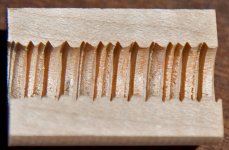First, I never seal my Radial or 3/8-10 threads. Both come out very clean with a very snug fit. IMO, most people seal their threads to (a) tighten up loose threads or (b) clean up ragged tapped threads - rather than to "seal" them from atmospheric influences. But to answer your question: no, the radial threads were not sealed. I don't think it would have helped much anyway. Keep in mind this is a close up shot that shows every detail. Radial tapped holes typically yield the cleanest thread possible. Cutting into any thread form in maple will probably create some tearout/fracturing due to the nature of the wood itself. Imagine how much worse it would have been had a tap been used instead of live tooling!
Second, all internal threads have a sharp, deep major diameter. When starting to screw on a shaft, the pin will pick up one of the two starting grooves NOW. You have a 50-50 chance that it will be the wrong one. If you're upset, impatient or impaired, you can do some damage real quick. If you're careful, you can probably get away with it if you stop tightening as soon as you feel some unnatural resistance.
FWIW, std 60 degree threads locate on the pitch diameter - not the major (outer) diameter. I prefer the modified 3/8-10 thread that locates on the minor diameter much like the radial.
No criticism inferred. Thoughtful questions are always welcome.
